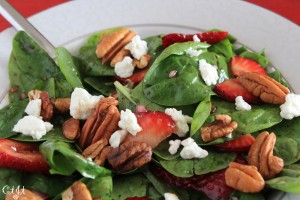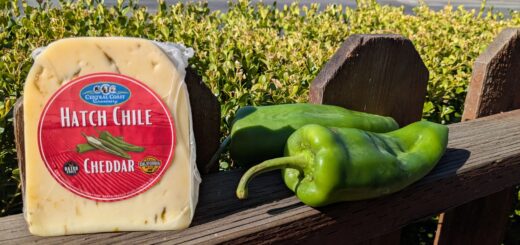Think You Know Strawberries? Think Again!

Geri Wohl, CNC www.bettereatingcoach.com
If you like strawberries, you are in good company as they are the most popular berries throughout the world. Strawberries, harbingers of summer, are now in season and bursting with flavor. Members of the rose family, strawberries are actually not considered a “true” berry since their seeds are not inside the red, heart-shaped fruit we eat. Instead, strawberries have about 200 seeds on the outside of the fruit.
Did you know that strawberries are native to every continent except Africa and Australia? Today, over 25,000 acres of strawberries are planted annually in California resulting in over 1 billion pounds of strawberries produced. Fortunately, here in California, we don’t have to worry about shipping strawberries long distances since over 80% of strawberries grown in the US are from our Golden State.
Strawberries are an excellent source of vitamins C and K, dietary fiber and flavonoids all with very few calories. A 3-½ ounce serving (100grams or 2/3 cup) is only 32 calories! Strawberries are mainly made up of carbohydrates. Carbs are our body’s main source of energy. The sugars found in strawberries are glucose and fructose, both simple sugars that are easy for us to break down and utilize. Even though carbs are the main macronutrient in strawberries, they only make up 8% by weight of the fruit. 91% of strawberries are water with a small amount being fat and protein. Strawberries also contain manganese, some of the B vitamins, folic acid and iodine. So let’s go into the components in a bit more detail.
 Even with the simple sugars found in strawberries, these berries have a low glycemic index of 41. This may be due to the dietary fiber found in strawberries and it’s high water content. The glycemic index is a way to measure how quickly foods release glucose (sugar) into the blood stream and raise one’s blood sugar levels. The goal is to keep your blood sugar within a range that doesn’t trigger excess insulin production and insulin resistance that can ultimately lead to diabetes.
Even with the simple sugars found in strawberries, these berries have a low glycemic index of 41. This may be due to the dietary fiber found in strawberries and it’s high water content. The glycemic index is a way to measure how quickly foods release glucose (sugar) into the blood stream and raise one’s blood sugar levels. The goal is to keep your blood sugar within a range that doesn’t trigger excess insulin production and insulin resistance that can ultimately lead to diabetes.- Vitamin C supports our immune system and is a powerful antioxidant. It also helps in collagen formation and is anti-inflammatory. Foods containing vitamin C should be consumed raw as heat will denature vitamin C and inactivate its beneficial properties.
- Vitamin K is extremely important for both our bone health and blood clotting. For more info on this, see my article http://www.bettereatingcoach.com/121112-its-good-to-be-green.html.
- The B vitamins and folic acid are all essential co-factors in the metabolism of macronutrients (proteins, carbohydrates and fats). They are also an important source to provide energy to the cells.
- 2/3 of a cup of strawberries contains about 2 grams of dietary fiber or 8.5% of the daily value of fiber needed in the diet. As explained in previous articles, dietary fiber supports our digestive health, assists in escorting the LDL (bad) cholesterol out of the body and even aids in weight loss. To read more about fiber, see my article http://www.bettereatingcoach.com/22713-not-just-dijon.html.
- One of the important flavonoids in strawberries is called anthocyanidin. It’s what gives strawberries their bright red color. The deeper the color, the more antioxidant properties the food possesses. These flavonoids protect the body against free radicals. Research from many studies concludes that anthocyanidins may protect us against cancer formation, heart disease and other inflammatory conditions. Strawberries’ antioxidant potential or ORAC value is 3577 units falls within the optimal range set by the NIH. For more about ORAC values, see my article http://www.bettereatingcoach.com/5813-spice-it-up.html.
Strawberries are easy to grow at home. Kids love to pick the berries and eat them right off plant. If you don’t have room to grow them, there are farms that will allow you to pick them and bring them home. My children loved this activity, which always coincided with the end of the school year.
Once picked, strawberries are highly perishable and need to be refrigerated. They should ideally be eaten within 2 days of purchase. Choose berries that are firm, free of mold and a deep red color. Once they have been picked, they will not ripen further. The medium sized berries often are more flavorful than the large berries—bigger is not always better. Wash berries right before consuming since moisture promotes mold formation on strawberries. As many conventionally grown strawberries are sprayed with pesticides, it is best to buy organically grown strawberries. If non-organic strawberries are purchased, see my tips for washing non-organic produce at http://www.bettereatingcoach.com/7912-a-peach-a-day.html.
Enjoy these luscious fruits in smoothies, salads, oatmeal or just by the handful. They are delicious and healthy!











